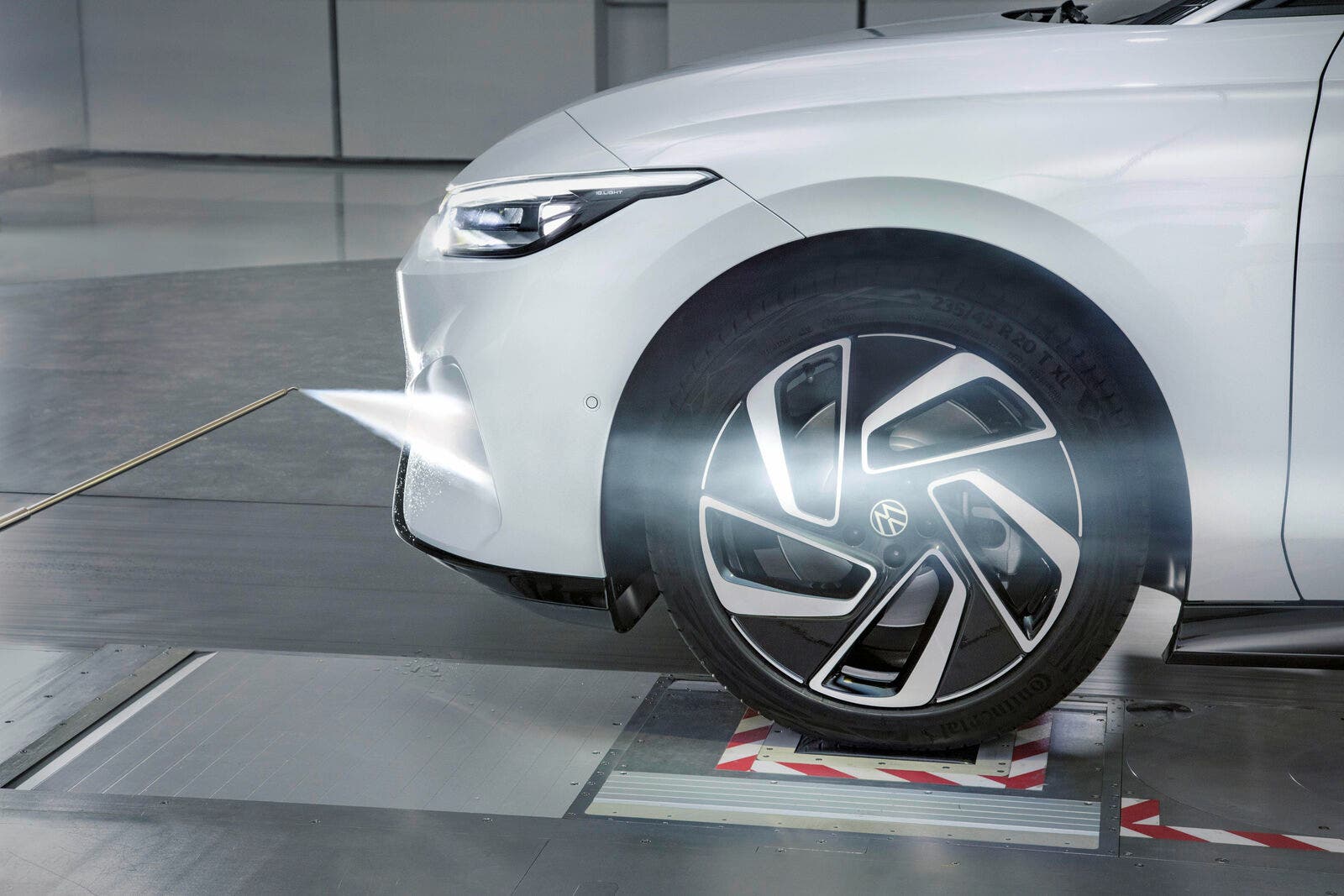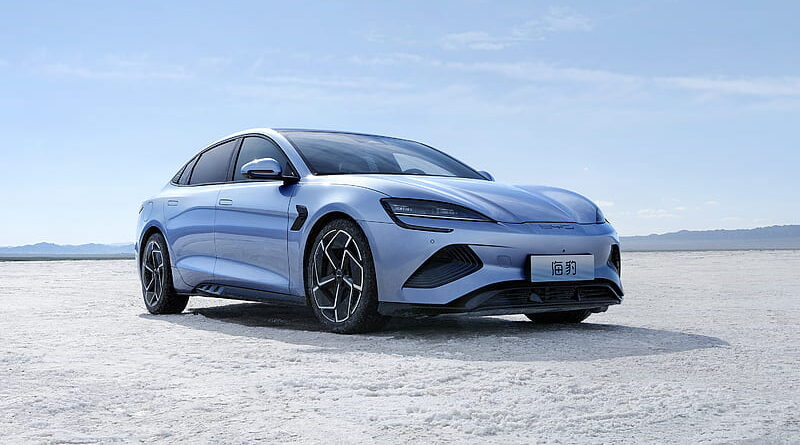
An electric car is much more efficient than a car powered by an internal combustion engine. That’s good. But the battery in today’s electric cars hold only a fraction of the energy stored in a tankful of gasoline or diesel. That’s bad. To make up for that shortcoming, an EV like the forthcoming Volkswagen ID.7 sedan has to use sophisticated strategies that allow it to slip through the air with a minimum of drag. The amount of drag is logarithmic, which means if you double the speed, drag increases by a factor of 4. That’s why driving your electric car on the highway at 85 mph sucks up electrons at such an astonishing rate.
Volkswagen is close to starting production of the ID.7, a battery-electric sedan that the company happily refers to as a limousine because of its generous interior space. An extraordinary amount of work has gone in to making the ID.7 as aerodynamically efficient as possible. According to a company press release, the car will have a coefficient of drag of 0.23 and a frontal area of 2.46 square meters. To know how slippery a car is through the air, you have to know both the Cd and the frontal area, but most manufacturers do not supply the latter.
A Focus On Aerodynamics
With limousines like the ID.7, the body shape accounts for about 50 % of the Cd value, Volkswagen says. The wheels and tires influence about 30%, the underfloor 10%, and the functional openings through which air flows to the radiators in the vehicle front end, for example, are another 10%. Volkswagen designer Daniel Scharfschwerdt says, “When designing the ID.7, there was a greater focus on aerodynamics than for practically any other model. This can be seen in the low front end, the flowing transition into the bonnet, and the fast windscreen. The coupé-like roof form and the tapering rear end are also designed for ideal aerodynamic performance.”
Intensive work was carried out on the exterior design, as well as on the underbody, wheels, and other fine details from the very start of the design phase for the new car. Stephan Lansmann, the project engineer responsible for the ID.7’s aerodynamics, says, “We strive for ideal solutions in an iterative process, which includes regular consultation between the Development and Design departments. There are many small steps here that pay off in the end. Numerous computer simulations for flow calculation are complemented by tests in a wind tunnel as part of this process.”
What we can’t see is the underside of the car, but it received careful attention from the designers. It is almost completely enclosed to smooth the flow of air beneath the car. The designers have also included small spoilers that guide the air along the wheels with minimum turbulence. Air curtains at the sides of the front bumper direct the air around the vehicle’s front end with a minimum of loss. The flared side sills prevent the air from flowing into the underbody area and shield the rear tires from air flowing onto them. In addition, small spoilers and trim panels guide the flow of air along the underbody of the car.
“On electric vehicles, the wheels make a greater contribution to good aerodynamics, and we therefore focused on them in particular,” says Lansmann. “When designing the wheel rims, the primary focus was on the aerodynamics, which we also had to match to the cooling requirements of the brakes. The resultant wheel rims are more closed and therefore have especially good aerodynamic properties.” Flow simulations were also used when designing the tire contours, which allowed the design team to optimize the car’s aerodynamics during the concept phase.
“Work only takes place virtually in the first year of development, with updates about every two weeks,” says Lansmann. The design team supplies CAD (Computer-Aided Design) data. Several thousand processors then calculate the air flow values, which include details like the door handles that are flush with the skin of the car and the aerodynamically-designed mirrors of the ID.7. “We go into the wind tunnel only when the design is stable. That can take a good one and a half years from the start of development,” according to Lansmann.
With the help of prototype parts made by a 3D printer, Lansmann’s team tested numerous variables. On the ID.7, this process allowed them to optimize the upper and lower mirror housing sections and mirror base to achieve a lower drag coefficient with outstanding aerodynamic properties. The culmination of all this work is a car that has the best aerodynamics of any production Volkswagen ever made.
The Volkswagen ID.7 As A Rolling Concert Hall
With a lack of wind turbulence thanks to its excellent aerodynamic design, the interior of the ID.7 is the ideal place to enjoy music while driving. The Harman Kardon premium sound system in the ID.7 offers listeners far more than just music reproduction — it unlocks all the nuances of finely tuned sound, the company says.
Thanks to hundreds of hours of tuning by Harman Kardon engineers working closely with Volkswagen’s teams, the sound system is finely adjusted to support superior audio performance, regardless of the road ahead. The audio system includes 14 speakers and 16 channels, including a subwoofer and center speaker. A Fraunhofer Sonamic Panorama algorithm, plus four different sound modes, provide a precise, detailed, wholly unique listening experience in which both music and the spoken word seem as natural as if they were created right in the vehicle. The result is a truly thrilling and high-quality driving and listening experience for drivers and passengers alike.
Harman Kardon boasts that its experts are fully up to the challenge of creating an ideal sound system for each specific vehicle interior. In the Volkswagen ID.7, the cutting edge technology of the Fraunhofer Sonamic Panorama algorithm separates the individual sound sources of a stereo recording, evenly distributing them across a U-shaped sound stage that envelopes and immerses everyone in the vehicle. The result is that each listener can appreciate the details that would otherwise be imperceptible.
The Harman Kardon sound system also features sound focus seat optimization technology in which specific seats can be highlighted for the best listening experience, either all-seat optimization, front seat only, driver only, or rear seat only. And to give listeners the freedom to personalize their listening experience, the system includes a choice of four sound settings. Each accentuates a different sonic aspect, allowing listeners to adjust the system and enjoy varied sound reproduction that ensures a completely new perception of the sound.
The Takeaway
My colleague Remeredzai Joseph Kuhudzai wrote in April that he sees the ID.7 as a worthy successor to his much loved Volkswagen Passat. At nearly 5 meters long with the abundance of interior space electric vehicles make possible, the new electric sedan from Volkswagen, which rides on the company’s highly configurable MEB platform, should be a delight to drive for those who can survive without having the letters “SUV” associated with their personal vehicle. The company has yet to release pricing information for the ID.7, which is expected to start shortly with the first deliveries in China followed by the US and Europe.
Sign up for daily news updates from CleanTechnica on email. Or follow us on Google News!
Have a tip for CleanTechnica, want to advertise, or want to suggest a guest for our CleanTech Talk podcast? Contact us here.
Former Tesla Battery Expert Leading Lyten Into New Lithium-Sulfur Battery Era — Podcast:
I don’t like paywalls. You don’t like paywalls. Who likes paywalls? Here at CleanTechnica, we implemented a limited paywall for a while, but it always felt wrong — and it was always tough to decide what we should put behind there. In theory, your most exclusive and best content goes behind a paywall. But then fewer people read it! We just don’t like paywalls, and so we’ve decided to ditch ours. Unfortunately, the media business is still a tough, cut-throat business with tiny margins. It’s a never-ending Olympic challenge to stay above water or even perhaps — gasp — grow. So …






